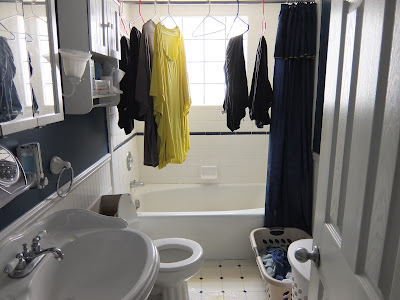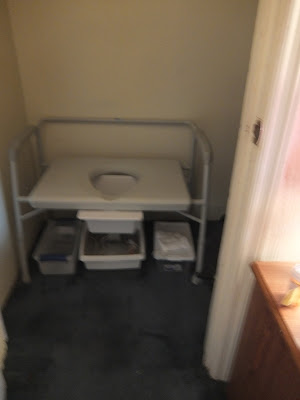 |
| Out growing the house. |
Functional Mobility:
- Utilizes a scooter to access the community.
- Ambulates short distances with a walker.
- Transfers with minimal assistance.
Mike lives on the first floor of a home that was built in the 1920's. Mike's scooter can access the kitchen but not the rest of the house because the door between the kitchen and the living room is not wide enough for his scooter. Mike utilizes a walker to access the family room and bedroom.
When Mike needs to use the bathroom he utilizes a bariatric commode that is placed in the bedroom closet. Mike is not able to access the current bathroom at all.
Mike's walker is 32" wide, the hallway to the bedroom and the bathroom is 30" wide so when Mike would like to access his bedroom his caregiver has to carry the walker to the bedroom while Mike ambulates down the hall holding onto the walls to support. There were several holes in the walls where Mike has lost his balance and fallen against the wall. Mike has not been able to enter the bathroom in several years.
Diagram of the existing house:
Issues with existing house:
- Can't access living room, bathroom or bedroom with scooter.
- Can't access bathroom at all.
- Hallway is not wide enough for scooter or walker.
 |
| Access to hallway to bathroom and bedroom from living room. |


Hallway from living room to bedroom. Holes from Mike falling when walking to bedroom.
 |
| Current bathroom. |
 |
| Commode |
Problems/Solutions:
- Kitchen/living room door too narrow to allow scooter access: No brainer, will widen door.
- Hallway too narrow to access via scooter or walker: The hallway being 30" wide actually helps Mike to retain his balance while walking but does not allow for Mike to maintain his balance adequately to be safe. Hallways in my opinion are a waste of space so instead of widening the hallway we will be installing a new doorway and incorporating the existing hallway into the bathroom to allow more space in the bathroom.
- We will need to shorten the wall between the bathroom and Mike's bedroom in order to allow turn radius for his scooter.
- Will install a new door on the bathroom across the existing hallway for visitor access.
- Bathroom is small and not accessible:
- The bathroom is only 5' wide and the toilet in the middle of the bathroom blocks access to the shower.
- We will move the toilet to the back of the bathroom and configure the middle of the bathroom into a shower to allow a 5'x 5' turn radius in front of the toilet and access to the sink.
- The bathroom will be a wetroom with skid-resistant flooring that runs up the walls 4" and acrylic panel walls. I would love to install safety mirrors that don't fog up for the walls to assist with showering and grooming but there is not enough money in the budget.
- The sink is being moved to the opposite wall to allow access to the sink without having to turn the scooter 180-degrees when entering from the bedroom.
Details and worries:
- Wet room floor: The flooring for the wetroom floor will be Altro Suprema flooring. Altro Suprema flooring is a commercial flooring used in locker rooms and by pools. Altro Suprema comes in 40 colors and has a slip resistance of .85, ADA requires a slip resistance of .60 or above. Slip resistance is important for Mike during transfers and his caregivers when helping him with bathing.
| Altro Suprema, Paprika- .85 slip resistance |
- Toilet:
- Mike would like to sit directly on the toilet, but transferring onto a toilet puts excess stress on the toilet seat and flange. Broken toilet flanges for people who transfer onto toilets is a common issue. With Mike's weight the toilet flange and the toilet seat would easily break, the bariatric commode will be required.
- There is a problem with the toilet backing up, would like a toilet that can handle big loads. Any suggestions?
- Grab bars: Mike is able to transfer with some assistance and is able to ambulate short distances. Small tasks like leaning forward to wash hands in the kitchen sink leave Mike out of breath with exertion. As an OT I would like to install grab bars to promote independent movement and safety so Mike can build up his endurance and not lose his transfer skills. As a builder I worry about installing grab bars that will not come out of the wall under Mike's weight which could very well increase.
- We once were called into fix a drop down grab bar for someone who was 300 pounds. The grab bar was firmly attached to a stud but the stud came out of the wall. We can't afford to take any sort of chances with Mike's safety. The handle of Mike's walker has already bent due to his weight.
Any suggestions or thoughts?


